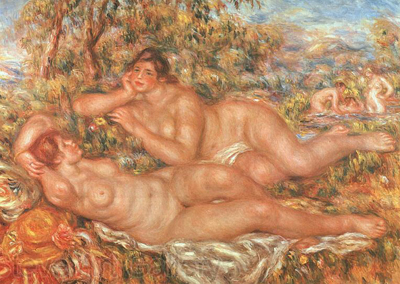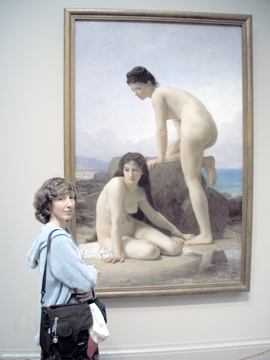|
Eventually, if you haven't already, you'll choose some favorite artist or artists whose style you would like to learn to emulate, at least until you gain enough painting experience to deviate from it and establish your own style. This is in fact the traditional way to learn to paint, down through the ages, and it still works fine. I had (and still have) several favorites of my own when I first started painting. One of them was William Adolphe Bouguereau (1825-1905), a superb student of the human form. Few people in the entire history of art could equal Bouguereau in representing the human body realistically in paint. The extent of his skill and reputation can be gauged by the amount of scorn heaped on him by "modernist" painters, much of it driven, I'm sure, by simple jealousy, of both of his skill and his success. But everyone, admirer and critic alike, concedes Bouguereau's skill. Even the acclaimed impressionist Auguste Renoir, toward the end of his life, abandoned his lovely, quirky style of painting, which so many people loved (and still do), to try to imitate Bouguereau's realism (and, sadly, failed, as the comparison below shows).
If classical realist painting is your ideal, poor Renoir's pneumatic ladies with their swollen bodies and shrunken heads just aren't in the same league with Bouguereau's perfectly formed maids. But Renoir had his strengths too (see below). Don't get me wrong, I love many of Renoir's paintings, mainly because of the beautiful colors and color combinations he used, whereas the colors in some of Bouguereau's paintings can be pretty bland by comparison. The real world is a rather drab place, color-wise, and pumping up color artificially as Renoir did is not always a bad thing. Great draftsmanship (drawing ability) isn't everything. But for straight realism, superb shading, and anatomical perfection, there's no denying that Willie B. gets the cigar. In the Bouguereau nude, above left, you can just feel the weight of the girl's lovely body against the soft grass, and you yearn to pass a hand down that long, soft thigh, and tell her that whatever it is that's bothering her, it will turn out all right. In the Renoir painting beside it, however, you get the feeling that if you touched one of those massive balloon women she might just rise up and float away, bobbing gently on the breeze, or worse (since someone obviously overinflated them) they might explode with a bang, leaving you covered in scraps of orange rubber--a ghastly thought. On the other hand, don't sell Renoir short. In the two portraits of girls below, I'll take the Renoir (at right) over the Bouguereau. Yes, Bouguereau's portrait of the little girl with the bird is as perfect as ever, but there's something more charming and appealing about the composition and color harmonies of Renoir's typically slightly off-kilter work.
Above left: Here the Bouguereau painting is a little too perfect. Of these two, Renoir's is a better picture aesthetically, in my opinion. Observe the two very different treatments of the girls' puffy sleeves. Good realist painting doesn't require photographic detail. Despite the stunning detail of the Bouguereau--the patterns on the tablecloth, the delicate filigree on the wall behind the girl, every wrinkle in the blouse correct, every tooth in the girl's smile delineated--it's all a bit too perfect. Just for something lovely to hang on the wall, and send little waves of good feeling over you every time you see it, give me the Renoir, in this case. Perfect detail and accurate color is not always the ultimate in a painting. I call both of these paintings realisitc, despite the element of impressionism in Renoir's. John Singer Sargent, famous for his society portraits, is another favorite painter of mine, whose work once again illustrates (literally) the fact that a great realist painting doesn't need to imitate a photograph. Below are two more similar portraits, another by Bouguereau (on the left), and one by Sargent. Both are lovely paintings, both are realistic, but again they demonstrate the difference between painting extreme detail and abbreviation of detail, the latter otherwise known as impressionism.
Both of these paintings are portraits of elegant ladies in shimmering gowns. The usual painstaking attention to detail is seen in Bouguereau's, on the left above, and on the right, we see how how Sargent dealt with such a subject. The women's hands look realistic in both portraits, but take a look at what happens (below, right) when you get right up close to Sargent's:
As you can see in my photo (above, left), with my friend Paul Rector standing beside the painting to provide scale, Sargent did large portraits, often life-size, probably because his wealthy customers wanted big paintings to display in their spacious homes (plus, they were paying plenty and wanted substantial results). With a painting this big, an artist can easily work plenty of detail into, say, a hand, if he chooses to, and a painter like William Bouguereau certainly would have done so. But Sargent obviously didn't consider it necessary. He never intended for his paintings to be viewed up close, for one thing. In fact, when painting a portrait, Sargent stood far back from it when deciding what to do next, then dashed up to the painting to dabble on some brush strokes, and then immediately retreated to view the result from a distance. The result is that his paintings look great from about 20 feet away, but not so great up close, if you love extreme detail. Was Sargent, then, an impressionist? We can be pretty sure that the wealthy clientèle who patronized him weren't much interested in impressionism; it was too avant-garde for most of them--what they wanted were realistic portraits. Nevertheless they did get a certain degree of impressionism, sometimes too much for their taste, if we give any credibility to the stories of unhappy Sargent sitters who begged him to come back and "fix" something in their portrait, or despairing, took a breadknife to it and destroyed the painting (thereby incurring the undying wrath of their descendants, who otherwise would have had a million-dollar Sargent painting to sell). Impressionism was a French specialty, and Sargent once said, unapologetically, that many people considered his portraits to be "beastly French." But Bouguereau was French, too, when you come right down to it, and nowadays the only people who consider Bougueareau's paintings "beastly" are the so-called "modern artists," those who do insane things like display blank canvases as great art. For a final comparison of Sargent's brand of realism to Bouguereau's, take a look (below) at how Bouguereau painted hands in a near life-size painting. In this case, (below left), my wife Lee is standing beside the painting to provide scale.
But back now to the topic of learning to paint by imitating your favorite artists. When I became the father of a little girl, and wanted to try to capture her beauty in paintings, I had no better teacher than Bouguereau. The man himself is long dead, of course, but his paintings are still everywhere, online, in museums, and in books, and they have much to tell us about his technique. And the best way to study is to copy, in oil paint just like the original. I spent many an hour painting copies of Bouguereau's paintings, before I undertook to create original paintings of my own compositions. Eventually I gained the confidence to try to paint my daughter in the Bouguereau style, and although I make no claims of being anywhere near the painter he was, I think I learned a few things about his methods during the many long hours I slaved over the copies, endlessly repainting my mistakes and trying, trying again until the results were close to the his. "No pain, no gain," applies very much to learning to paint realistically. The first of Bouguereau's paintings that I copied was his "Storybook," and one of my first paintings of my daughter was posed in a similar fashion:
Below are another couple of Bouguereau's paintings of girls, compared to one of mine.
And finally, we might sum up the styles of these three painters with their own self-portraits, since they painted their own faces the same way they painted everything else: Bouguereau with meticulous detail, Renoir with saturated colors and minimal detail, and Sargent, realistically with the fewest possible brushstrokes.
On the next page of these art lessons I'll discuss how to go about learning to paint realistically. |



















